5. Gravity and the Secret Inside the Pyramid
To tell the exact time, ships sailing the oceans in days long gone had to rely on hourglasses. Regular clocks would be rocking with the boats on the water, and their pendulums would not be able to maintain a regular swing. Without the exact time, a boat could not navigate its way around the world in an accurate manner, be it day or night.
Every day at noon, the sun and the ship’s position would be aligned, and the hourglass told the time from that moment on until noontime the next day. The chance that this occurred exactly 24 hours later is rather slim. Using the hourglass is a good approximation of time, but not one without deviations. And sailing for an entire day, noon time the next day is found most likely in a different spot on our planet, probably more than a few geographical minutes and seconds away from the previous bearing.
The invention of the watch made it possible to tell the time at any moment of the day anywhere on the planet, rocking boat or not. The parts of a watch are so minuscule that a balance of actions made accuracy possible; gravity has no grip on its functioning. Hold it upside down and a watch tells the time as if nothing happened.
Something similar is happening with the planets. Our solar system contains a plane in which the planets are aligned, better known as the zodiac. With the Milky Way…
